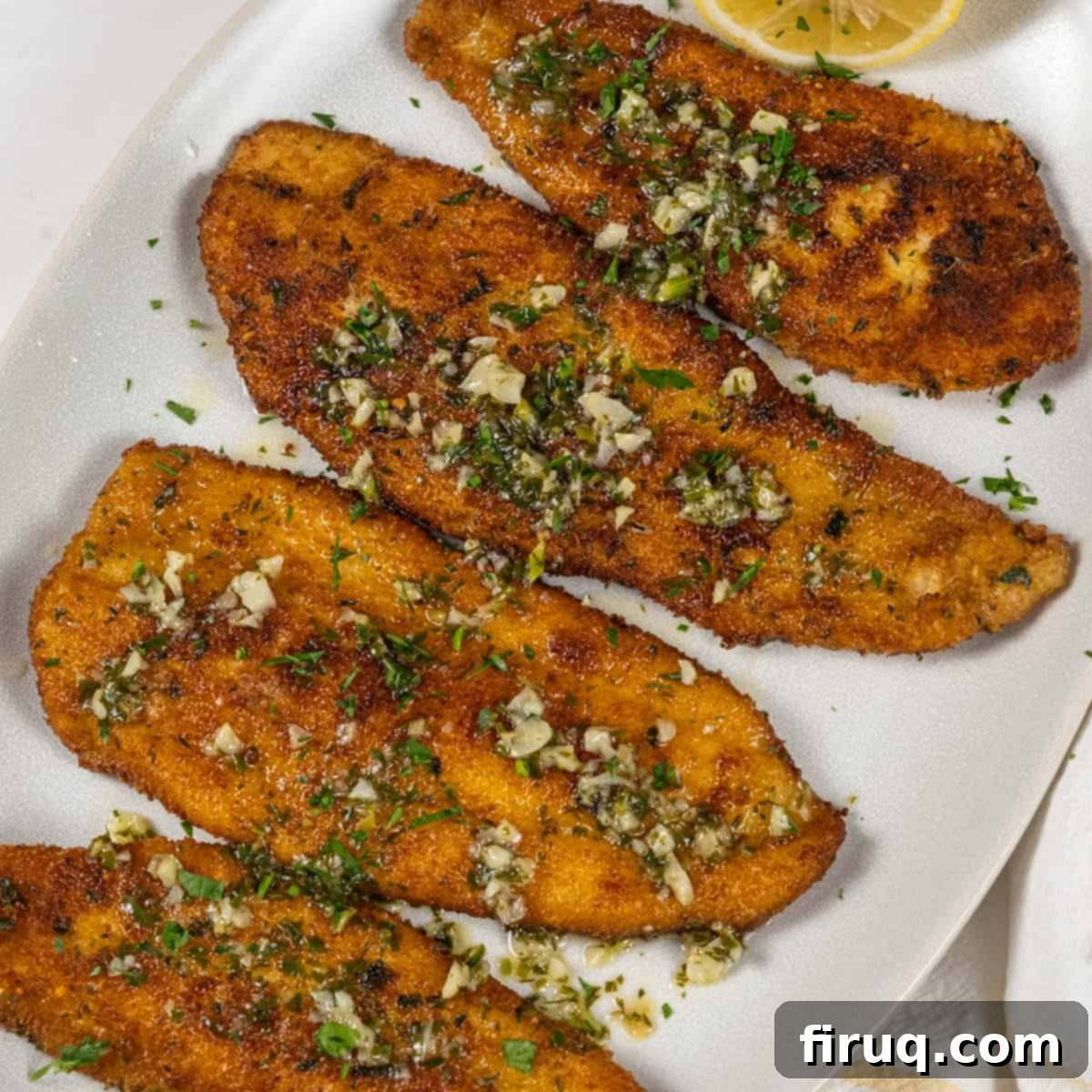The Best Fried Flounder Oreganata: Crispy, Moist & Flavorful Italian Fish Recipe
Prepare to elevate your seafood experience with this truly exceptional crispy and incredibly moist Fried Flounder Oreganata. Each golden-brown fillet is delicately fried to perfection, then generously drizzled with a bright, zesty lemon garlic butter sauce that promises to tantalize your taste buds. If you’ve ever felt intimidated by cooking fish, this easy-to-follow Italian recipe is designed to take the fear out of seafood and guide you to a restaurant-quality meal right in your own kitchen.
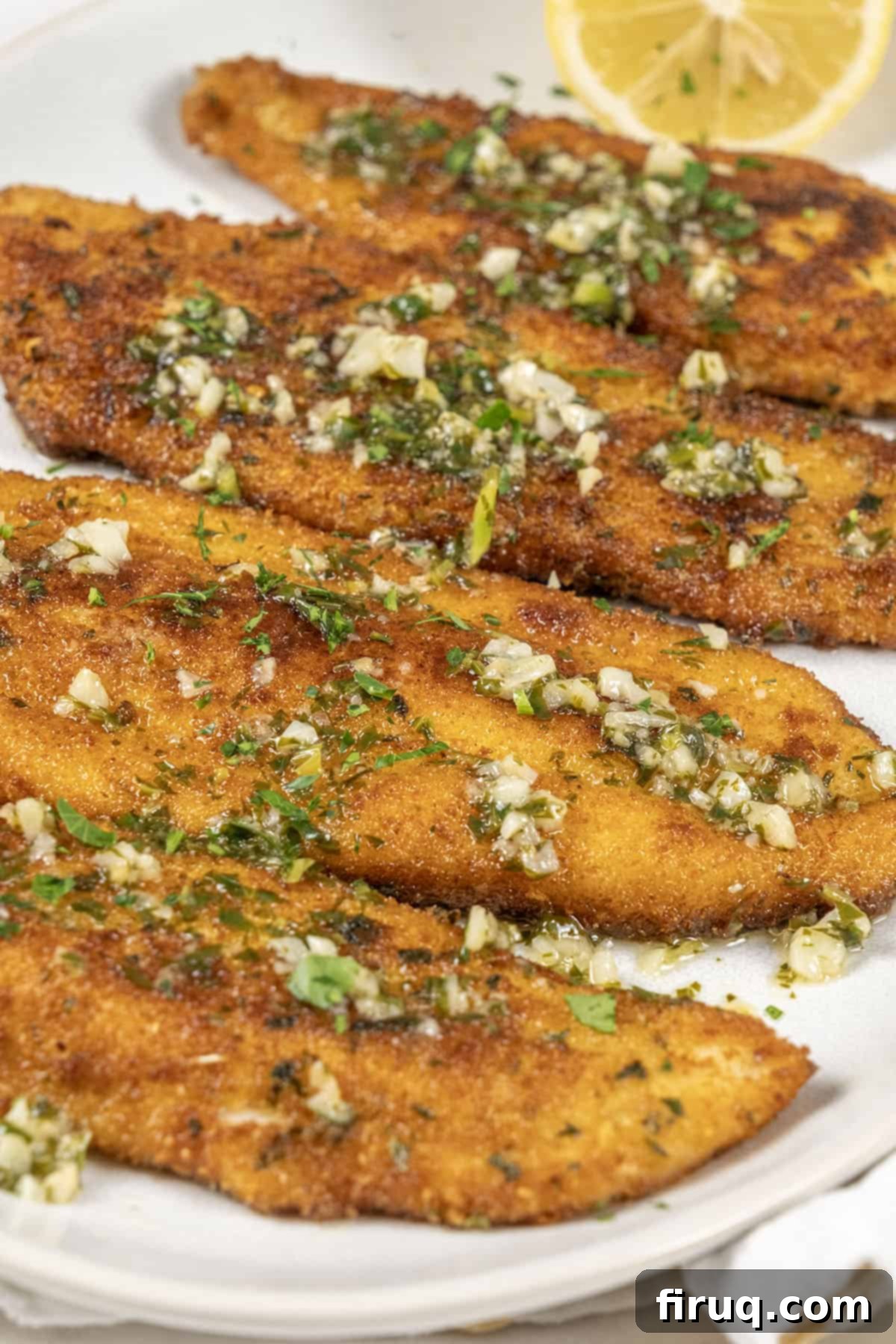
While this Fried Flounder Oreganata is a standout dish, you might also enjoy exploring some of our other fantastic seafood recipes that highlight fresh flavors and simple techniques. Consider trying our Pan-Seared Vermillion Snapper for a firm, flaky option, or our unique Pistachio Crusted Fish if you’re looking for an added textural crunch and nutty flavor. Each recipe offers a delightful way to enjoy the bounty of the sea!
[feast_advanced_jump_to]
Why This Recipe Is a Must-Try
This Fried Flounder Oreganata holds a special place in my heart, deeply rooted in family traditions. Growing up, seafood oreganata was a common sight at our dinner table, particularly on special occasions. My mom often prepared dishes like Lemon Pistachio Crusted Snapper or her signature Lemon Garlic Broiled Flounder. As kids, my brothers and I weren’t always enthusiastic about fish, often rolling our eyes at the announcement. It’s a common story, isn’t it? The challenge with seafood, especially for younger palates, is that no matter how exquisitely prepared, a child’s mind often remains unconvinced that “it tastes like chicken.”
However, my parents never forced us to eat fish. Instead, they consistently offered us the opportunity to try it, fostering a low-pressure environment. This approach eventually paid off, as all of us, now adults, have grown to genuinely appreciate and enjoy fish. This specific flounder dish perfectly illustrates that journey. It’s not only incredibly flavorful but also remarkably simple to prepare, making it an excellent gateway for anyone looking to embrace seafood cooking.
Flounder, in particular, is an ideal choice for this recipe due to its inherently mild, delicate, and slightly buttery flavor profile. Its subtle taste makes it incredibly versatile, allowing the vibrant flavors of the oreganata breading and the bright lemon garlic butter sauce to truly shine without being overwhelmed. Its tender, flaky texture after frying is simply irresistible. This dish has become such a beloved staple that it frequently features on Our Feast of Seven Fishes Menu for Christmas Eve, a testament to its crowd-pleasing appeal and festive charm. It’s a recipe that marries tradition with undeniable deliciousness, sure to become a favorite in your home too.
Ingredient Notes and Expert Substitutions for Your Flounder Oreganata
Understanding your ingredients is key to culinary success. Here’s a deeper dive into what makes this Fried Flounder Oreganata so special, along with useful tips for substitutions.
Flounder: The Star of the Dish
Flounder is truly a fantastic choice for this recipe, thanks to its wonderfully mild flavor and delicate, flaky texture. It’s a “white fish” that cooks quickly and absorbs flavors beautifully. When selecting flounder, look for fillets that are bright, firm, and have a fresh, ocean-like scent, not overtly “fishy.” If fresh flounder isn’t available or you’re keen to experiment, several other mild white fish varieties make excellent substitutes. Consider using cod, tilapia, or striped bass. Each offers a similar delicate consistency and mild flavor profile, allowing you to discover which fish you enjoy the most with this vibrant oreganata preparation. This versatility is part of the joy of cooking seafood – the same delicious technique can yield subtly different, yet equally satisfying, results with various fish.
The Perfect Crispy Breadcrumb Mixture
Achieving that signature crisp exterior is crucial for a great fried fish, and it all starts with the right breadcrumb mixture. I’ve personally tested this recipe with multiple different iterations to find the ideal balance. We explored options like incorporating Parmesan cheese, pre-dredging in flour, and using various types of breadcrumbs, including light and airy panko breadcrumbs. Ultimately, the most consistently perfect texture and flavor came from keeping it simple: classic breadcrumbs, garlic powder, salt, and fresh chopped parsley. The simplicity allows the fish and the “oreganata” flavors to shine.
A common mistake I often hear about is using fresh minced garlic directly in the breadcrumb mixture. While fresh garlic is wonderful, it’s a terrible idea for this particular application. Flounder cooks incredibly fast, typically requiring only about 3-4 minutes per side in hot oil. Fresh garlic, on the other hand, burns in a mere 20 seconds when exposed to high heat. Adding fresh garlic to your breading guarantees that you will end up with unpleasantly burnt garlic bits on your beautifully fried fish. Stick to garlic powder here; it provides all the aromatic flavor without the risk of charring.
The Bright and Zesty Lemon Garlic Butter Sauce
This lemon garlic butter sauce is technically an optional component of the recipe, but I wholeheartedly recommend it. It’s an absolute flavor enhancer that transforms the dish from delicious to extraordinary. Easy to prepare, this sauce adds an extra layer of bright, lemony tang and rich, buttery goodness that perfectly complements the fried flounder. The acidity cuts through the richness of the fried fish, creating a beautifully balanced bite. If you’re short on time or prefer a lighter touch, you could certainly skip the full sauce and simply opt for a refreshing spritz of fresh lemon juice and a delicate sprinkle of sea salt to finish off the dish. However, for maximum flavor impact, the full sauce is truly worth the minimal extra effort.
How to Make Flounder Oreganata: A Step-by-Step Guide to Perfection
Crafting this delicious Fried Flounder Oreganata is simpler than you might think. Follow these detailed steps to achieve a perfectly crispy and flavorful fish every time.
Preparing the Flounder for Frying
I begin by meticulously preparing the flounder fillets. If your flounder comes with bones, removing them can sometimes feel like an absolute pain in the butt. My preferred method is to first locate the spine with my fingers, feeling for the central bone structure. Once identified, I carefully cut down along both sides of the spine to completely remove the entire bone section. This ensures boneless, fork-tender pieces of fish for an easier and more enjoyable eating experience. You can refer to the video embedded below to see a visual demonstration of this deboning technique.
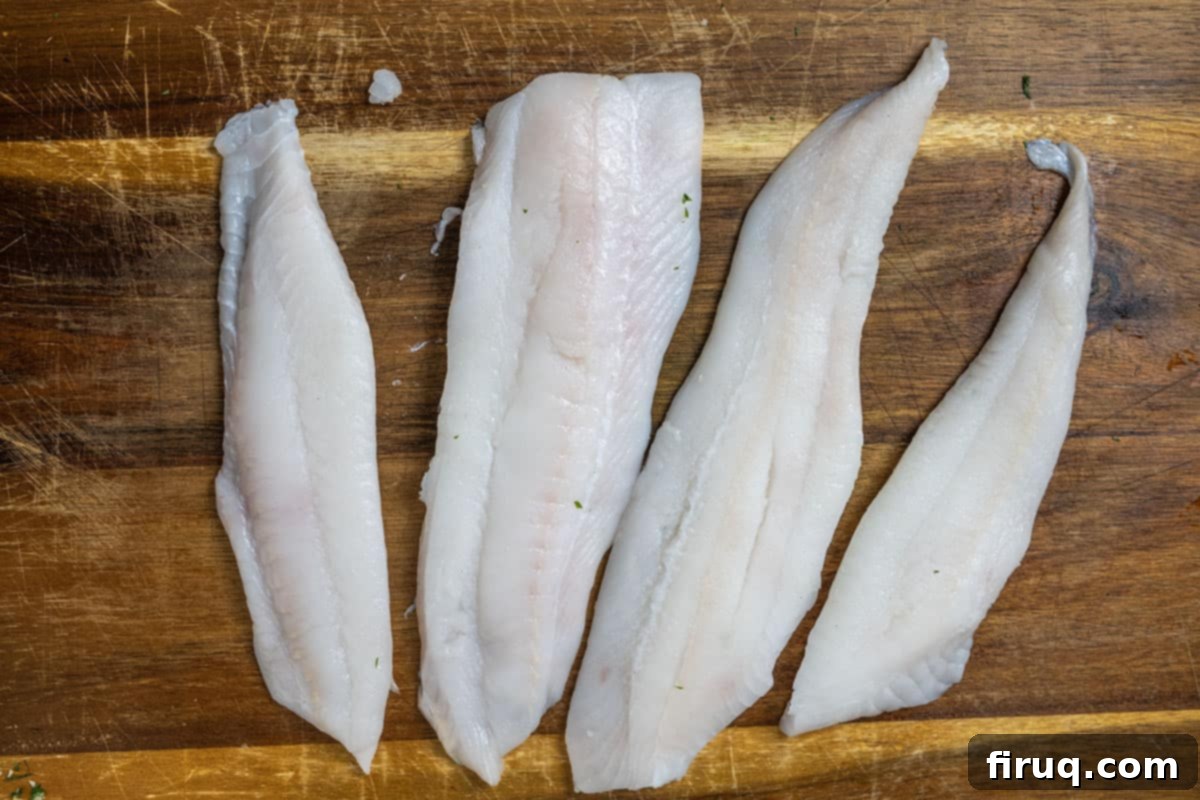
After deboning, I cut down both sides of the spine to efficiently remove the entire bone structure, yielding smaller, more manageable pieces. The next crucial step is to gently pat the fish dry with paper towels to remove any excess moisture. This is vital for achieving a truly crispy crust when frying. From two whole flounder fillets, you’ll typically end up with about four perfectly portioned pieces of fish, ready for breading.
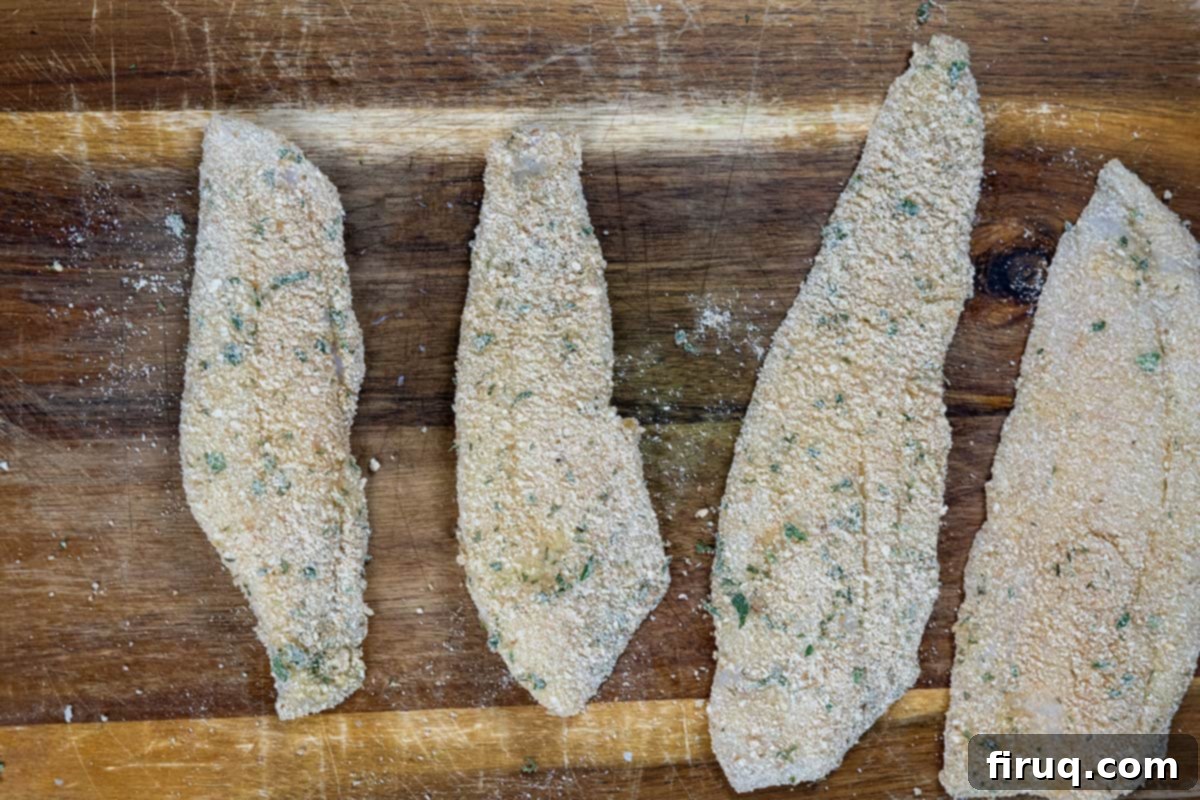
Step 1: Breading the Flounder for Maximum Crispness. To begin the breading process, combine the breadcrumbs, salt, garlic powder, dried oregano, and vibrant fresh chopped parsley in a shallow dish or a wide, deep plate. Whisk one egg in a separate shallow bowl until well beaten. Take each piece of dry flounder, first dip it thoroughly in the beaten egg, ensuring it’s completely coated, then transfer it to the breadcrumb mixture. Gently press the breadcrumbs onto both sides of the fish, making sure each fillet is evenly coated. Set the breaded flounder aside on a clean plate or wire rack. This step can even be done a few hours in advance, allowing the breading to adhere well, which can sometimes lead to an even crispier result.
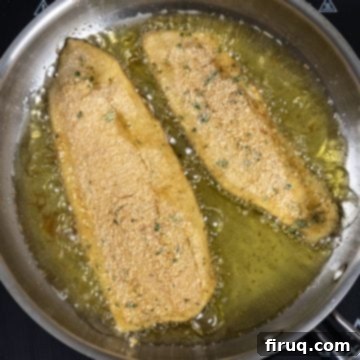
Step 2: Frying the Flounder to Golden Perfection. Heat about ½ cup of olive oil in a large frying pan over medium-high heat. It’s crucial that the oil is adequately hot before adding the fish to ensure a crispy crust and prevent the fish from absorbing too much oil. Once the oil shimmers and a tiny breadcrumb sizzles upon contact, carefully add the breaded flounder fillets, making sure not to overcrowd the pan. Fry the fish for approximately 3-4 minutes on the first side. After 3 minutes, gently lift an edge with a spatula to check for a beautiful golden-brown color.
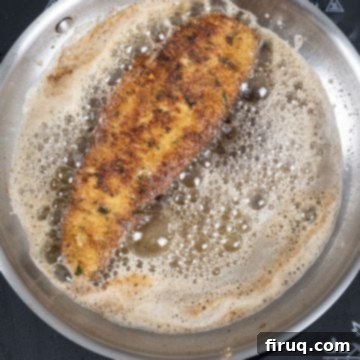
Step 3: Ensuring Proper Doneness and Moisture. Once the first side is beautifully golden brown, carefully flip the fillets and fry for another 3-4 minutes on the second side. The ultimate goal is for the internal temperature of the fish to reach 145℉ (63℃). For absolute precision and to guarantee that your fish is both moist and, of course, properly cooked to the correct safe temperature without overcooking, I highly recommend using an instant-read thermometer. This simple tool is your best friend when cooking fish, preventing dry, rubbery results. Remove the perfectly cooked flounder from the pan and place them on a wire cooling rack set over a baking sheet to drain any excess oil, helping to maintain their crispiness. Immediately sprinkle them with a pinch of salt to enhance their flavor.
Crafting the Irresistible Lemon Garlic Butter Sauce
This vibrant sauce is nothing short of absolute gold and is incredibly versatile. It can elevate not only this flounder dish but truly any seafood meal. Imagine it drizzled over perfectly sautéed shrimp or our delightful pan-seared snapper – it’s a game-changer.
Step 4: Preparing the Aromatic Sauce. In a small frying pan, add 2 tablespoons of olive oil and heat it over medium heat. Add the minced garlic and sauté it for about 1 minute, just until it becomes wonderfully fragrant. Be careful not to let it brown. Immediately after, squeeze in the fresh juice from half a lemon. Allow this mixture to simmer gently for about 30 seconds, letting the flavors meld. Then, add the unsalted butter and stir continuously until it has completely melted and combined with the lemon-garlic oil. Finally, stir in the fresh parsley and remove the pan from the heat. This quick process ensures the sauce remains vibrant and fresh.
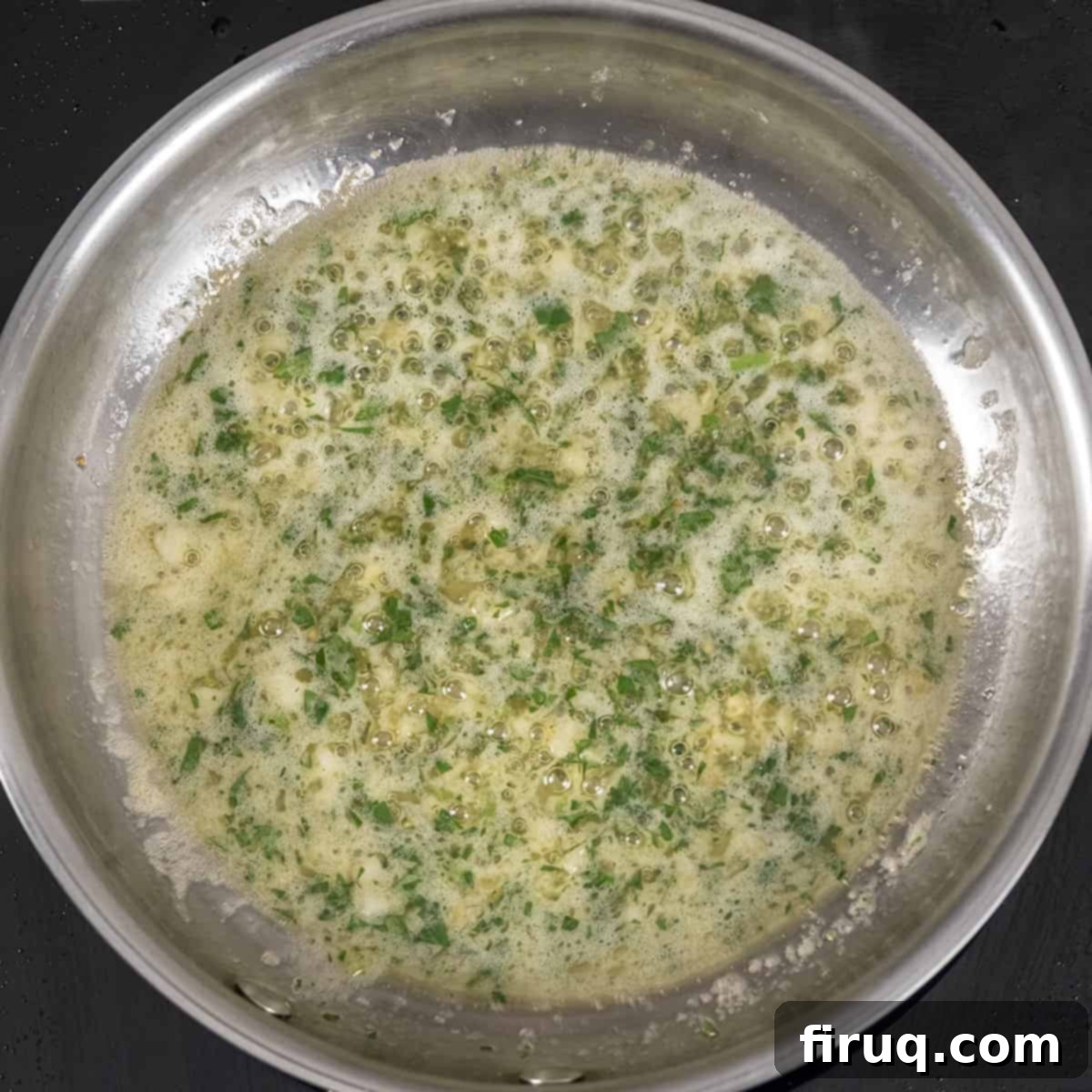
Step 5: Drizzling and Serving. The key to enjoying this sauce at its best is immediate application. Drizzle the fried flounder with the sauce immediately after it’s made. If the sauce is left to sit for too long, it will begin to separate, diminishing its beautiful emulsified texture. For this reason, I always prepare this lemon garlic butter sauce right after I’ve finished frying the fish. It’s a quick process, and the flavor is undeniably best when fresh and warm. Serve everything immediately to enjoy the ultimate combination of crispy fish and zesty, rich sauce!
Pro-Tips for Perfect Fried Flounder
Achieving restaurant-quality fried flounder is easier with these expert tips:
- **Ensure Your Oil is Seriously HOT:** This is perhaps the most critical tip for perfectly fried fish. Before adding your flounder, make sure the oil is *seriously* HOT. If the oil isn’t hot enough, the fish will absorb too much oil, resulting in a greasy, soggy crust rather than an even, crispy fry. It’s tempting to rush, but patience is key here. You only get one first try at putting the fish into the oil, and since the fish will naturally slightly cool the oil upon entry, you want to make sure it’s adequately hot before starting. Wait at least 5 minutes after placing the pan on the heat for the oil to heat through, or use a thermometer to reach 350-375°F (175-190°C).
- **Pat the Flounder Bone Dry:** Before dipping in the egg and breading, rigorously pat the flounder dry with paper towels. Any residual moisture on the fish surface will create steam when it hits the hot oil, preventing direct contact between the oil and the breading. This can lead to “wet spots” or a less crispy, unevenly browned crust after frying. A thoroughly dry surface is the secret to getting that consistent, golden, and exceptionally crispy exterior.
- **Don’t Overcrowd the Pan:** Frying in batches might take a little longer, but it’s essential for maintaining the oil temperature and achieving even cooking. Overcrowding the pan will drastically drop the oil’s temperature, leading to steamed, rather than fried, fish.
- **Season Immediately After Frying:** As soon as the fish comes out of the hot oil, sprinkle it with a little extra salt. The heat helps the salt adhere and enhances the overall flavor.
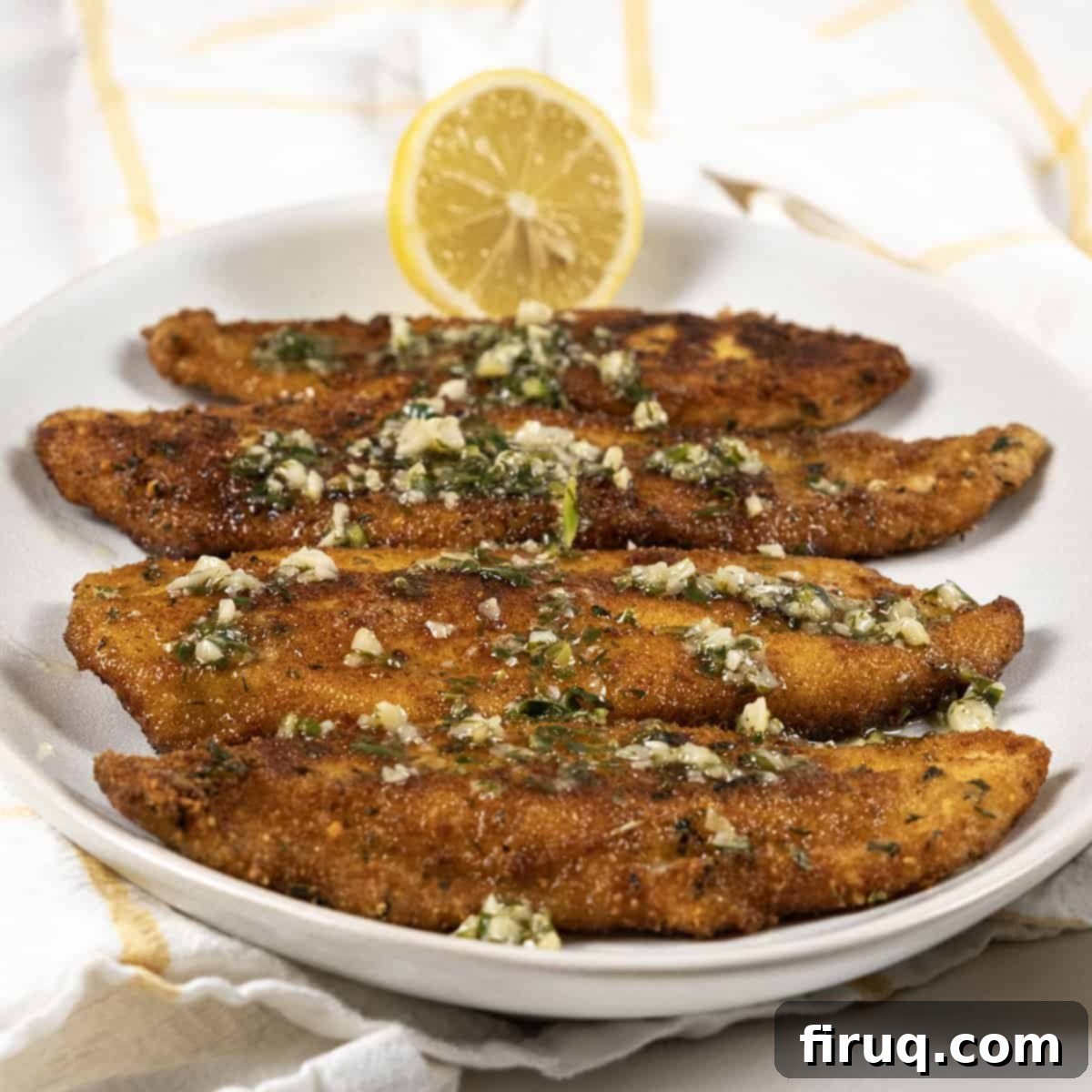
How to Reheat and Store Fried Flounder Oreganata for Best Results
While Fried Flounder Oreganata is undoubtedly best enjoyed fresh, there are effective ways to store and reheat leftovers to maintain as much of its deliciousness as possible.
Storage: To store any leftover flounder, allow it to cool completely to room temperature. Then, transfer the fillets to an airtight container and place them in the refrigerator. Properly stored, the flounder will remain fresh and safe to eat for 2-3 days. The lemon garlic butter sauce can be stored separately in a small airtight container in the fridge as well.
Reheating: For the best results and to revive some of that wonderful crispiness, I recommend reheating the flounder in the oven. Preheat your oven to 375 degrees F (190°C). Place the fillets on a baking sheet, ideally on a wire rack to allow air circulation, and bake for 8-12 minutes, or until the internal temperature reaches 145 degrees F (63°C) and the exterior is hot and slightly crisped. If you have leftover sauce, gently warm it on the stovetop over low heat or in the microwave for a few seconds until just warm, then drizzle over the reheated fish.
I’ve also found that microwaving isn’t terrible for reheating, especially if you’re in a pinch. The fish will lose some of its crispiness and become softer, but it’s still delicious and moist. However, I just wouldn’t recommend reheating it in the break room at work – the aroma might not make you the most popular colleague!
Recipe FAQs: Your Questions About Flounder Oreganata Answered
Flounder is celebrated for being one of the most versatile fish, thanks to its incredibly mild flavor. While some might mistakenly call its mildness “boring,” I believe it’s its greatest asset, allowing the chef to infuse it with virtually any flavor profile they desire! Beyond this fantastic fried oreganata preparation, I also absolutely love broiled flounder. It’s quick, healthy, and lets the natural delicate taste of the fish shine through beautifully. There are also great options for baking, pan-searing, or even grilling, depending on your preference and desired texture.
Absolutely! Broiled Flounder is a wonderfully delicious and healthy alternative to frying. It’s one of the easiest and quickest ways to prepare flounder, resulting in a tender, flaky fillet with minimal oil. To broil, you can adapt the oreganata breading (or use a simpler seasoning), place the fish under a hot broiler for just a few minutes per side until cooked through and lightly golden. As with most seafood I prepare, whether fried, broiled, or baked, I highly recommend using an instant-read thermometer. This ensures that the fish reaches the safe internal temperature of 145°F (63°C) without becoming overcooked and dry, guaranteeing a perfectly moist and flavorful result every time.
For frying flounder, you want an oil with a high smoke point and a neutral flavor. Good options include olive oil (as used in this recipe), canola oil, vegetable oil, or grapeseed oil. These oils can withstand the medium-high heat required for frying without burning, ensuring your fish gets perfectly crispy and golden without any off-flavors.
What to Serve with Flounder Oreganata: Perfect Side Dishes
Fried Flounder Oreganata is just the delicious beginning of a truly great meal! To complete your dining experience, pairing it with the right side dishes can elevate the flavors and textures. Here are some of my top suggestions, ranging from fresh vegetables to hearty pastas, designed to complement the mild, crispy fish and zesty sauce:
- Vegetable Sides: For fresh, vibrant vegetable accompaniments that balance the richness of the fried fish, I highly recommend our Italian Cabbage Recipe for a savory and tender dish, our Italian Lacinato Kale Recipe (Tuscan) for a hearty green, or a crisp and refreshing Caesar Salad to add a classic, tangy crunch.
- Starchy Sides: If you’re looking for comforting starchy sides that soak up the lemon garlic butter sauce beautifully, consider our light and flavorful Lemon Spinach Orzo, the bold and savory Garlic Anchovy Pasta, a unique and aromatic Artichoke Pesto Pasta, or the simple yet elegant Lemon Pasta with Spinach.
- All-in-One Pasta Dishes: For a more substantial side that includes vegetables, making it a complete meal, I’d suggest our colorful Pasta Primavera with Broccoli and Asparagus, the fresh and seasonal Italian Summer Pasta with Zucchini, or the savory and satisfying Pasta with Peas and Pancetta.
- Hearty Soups: What’s better than pairing crispy fried fish with a warm, comforting bowl of soup? Try serving it alongside our wholesome Lentil Soup, a classic and robust Classic Italian Minestrone, or a hearty and flavorful Pasta Fagioli with Spinach. Each soup offers a delightful contrast in texture and temperature.
Explore More of Our Favorite Seafood Recipes
If you’ve fallen in love with this Fried Flounder Oreganata, then you’re sure to enjoy our other top-rated seafood dishes. Each recipe is crafted to bring delicious, fresh flavors to your table with straightforward instructions. Dive into more of our culinary creations and discover your next favorite meal!
- Lemon Pistachio Crusted Snapper
- Cast Iron Lemon Dill Salmon
- Garlic Sage Seared Scallops
- The Best Homemade Shrimp Cocktail
Please leave a comment and star rating below in the recipe card! We love to hear what you think of our recipes and how they turn out in your kitchen. Feel free to tag us on Instagram @vindelgiudice to share your culinary creations!
📖 Recipe
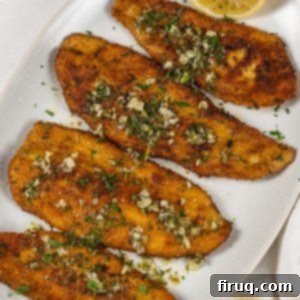
Fried Flounder Oreganata
Vincent DelGiudice
Pin Recipe
Equipment
-
1 large frying pan
-
1 small frying pan
-
1 medium bowl
-
1 large plate
-
1 instant-read thermometer (highly recommended)
Ingredients
- 2 flounder filets, about 1-1.5 lbs, deboned and patted dry
- ½ cup plain breadcrumbs (not panko, for best adhesion)
- 1 tablespoon garlic powder (do not use fresh garlic here)
- 1 tablespoon fresh chopped parsley, for breading
- 1 teaspoon salt, plus more for sprinkling
- 1 teaspoon dried oregano
- ½ cup olive oil, for frying (or other high smoke point oil)
- 1 large egg, beaten
Lemon Garlic Butter Sauce
- ½ fresh lemon
- 2 tablespoon olive oil, for sauce
- 2 cloves garlic, freshly minced
- 2 tablespoon fresh chopped parsley, for sauce
- 2 tablespoon unsalted butter
Instructions
-
Prepare the Flounder: Start by deboning the flounder fillets if necessary. Find the spine and cut carefully along both sides to remove the entire bone structure. Once deboned, pat the fish thoroughly dry with paper towels to remove all excess moisture. This is key for a crispy crust.
-
Bred the Fish: In a shallow dish, combine the breadcrumbs, garlic powder, dried oregano, fresh chopped parsley, and 1 teaspoon of salt. In a separate shallow bowl, whisk the egg until beaten. Dip each flounder fillet first into the beaten egg, ensuring it’s fully coated, then dredge it in the breadcrumb mixture, pressing gently to ensure a thorough and even coating. Set the breaded flounder aside on a clean plate or wire rack.
-
Fry to Perfection: In a large frying pan, heat ½ cup of olive oil over medium-high heat until shimmering and hot (around 350-375°F / 175-190°C). Carefully add the breaded flounder fillets to the hot oil, being careful not to overcrowd the pan. Fry for 3-4 minutes per side, or until the fish is golden brown and the internal temperature reaches 145℉ (63℃) with an instant-read thermometer. Remove the flounder and place it on a cooling rack set over a baking sheet. Immediately sprinkle with a little extra salt.
-
Make the Lemon Garlic Butter Sauce: While the fish is draining, in a small frying pan, add 2 tablespoons of olive oil and heat to medium heat. Sauté the minced garlic for about 1 minute until fragrant but not browned. Squeeze in the juice from half a lemon and simmer for 30 seconds. Add the unsalted butter and stir until fully melted and combined. Stir in the remaining fresh chopped parsley and remove from heat.
-
Serve Immediately: Drizzle the freshly fried flounder generously with the warm lemon garlic butter sauce. Serve everything immediately to enjoy the best crispy texture and vibrant flavors!
Notes
- Make sure the oil is HOT before adding the flounder, otherwise you will get an uneven, soggy fry. Wait until the oil is shimmering or reaches 350-375°F (175-190°C). Check the flounder for golden-brown crispness before flipping.
- Pat the flounder completely dry before egging and breading. This is crucial for achieving the crispiest fish without any “wet spots” after frying, as moisture creates steam and prevents crisping.
- Avoid using fresh garlic in the breading mixture, as it will burn in the short frying time. Stick to garlic powder for flavor without the char.
- Serve the lemon garlic butter sauce immediately after making it, as it can separate if left to sit.
Nutrition
